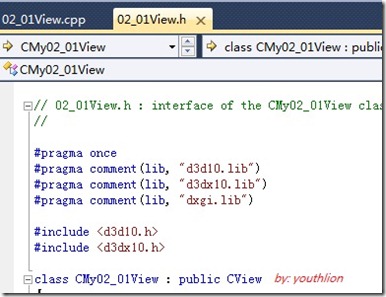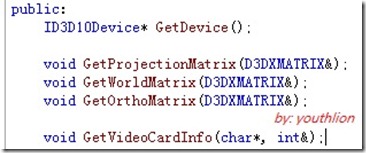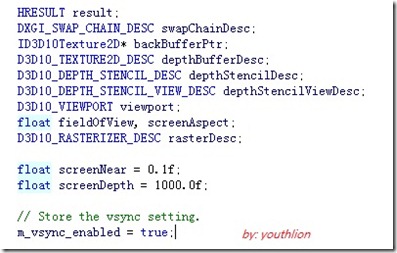DirectX10 学习笔记2:在多文档框架中初始化DirectX 10
显示功能是在视图类中完成的,所以DX10的初始化及绘制工作都是视图类中完成。
首先建立一个多文档工程,工程名为02_01,在视图类头文件中加载相关的库,并包含头文件:
在视图类的头文件中添加DX10相关的成员:
其中三个变换矩阵、m_device以及显卡有关信息通过五个公有函数访问:
下面是DX具体的初始化过程,封装为一个视图类的成员函数InitDX()。
DX初始化过程中需要创建设备和交换链,在创建交换链的时候用到和视图窗口有关的几个参数:窗口的宽、高和窗口的句柄:
接下来是交换链、纹理资源、2D纹理描述结构体等,其中screenNear和screenDepth是渲染的深度范围,m_vsync_enabled设置为真,表明后面会根据实际的硬件设备设置刷新率,否则是尽可能快地刷新:
以下代码填充DXGI_SWAP_CHAIN_DESC结构体中在初始化过程中用到的一些成员:
// Initialize the swap chain description.
ZeroMemory(&swapChainDesc, sizeof(swapChainDesc));
// Set to a single back buffer.
swapChainDesc.BufferCount = 1;
// Set the width and height of the back buffer.
swapChainDesc.BufferDesc.Width = screenWidth;
swapChainDesc.BufferDesc.Height = screenHeight;
// Set regular 32-bit surface for the back buffer.
swapChainDesc.BufferDesc.Format = DXGI_FORMAT_R8G8B8A8_UNORM;
// Set the refresh rate of the back buffer.
if(m_vsync_enabled)
{
swapChainDesc.BufferDesc.RefreshRate.Numerator = 1;
swapChainDesc.BufferDesc.RefreshRate.Denominator = 60;
}
else
{
swapChainDesc.BufferDesc.RefreshRate.Numerator = 0;
swapChainDesc.BufferDesc.RefreshRate.Denominator = 1;
}
// Set the usage of the back buffer.
swapChainDesc.BufferUsage = DXGI_USAGE_RENDER_TARGET_OUTPUT;
// Set the handle for the window to render to.
swapChainDesc.OutputWindow = hwnd;
// Turn multisampling off.
swapChainDesc.SampleDesc.Count = 1;
swapChainDesc.SampleDesc.Quality = 0;
// Set to full screen or windowed mode.
swapChainDesc.Windowed = true;
// Set the scan line ordering and scaling to unspecified.
swapChainDesc.BufferDesc.ScanlineOrdering = DXGI_MODE_SCANLINE_ORDER_UNSPECIFIED;
swapChainDesc.BufferDesc.Scaling = DXGI_MODE_SCALING_UNSPECIFIED;
// Discard the back buffer contents after presenting.
swapChainDesc.SwapEffect = DXGI_SWAP_EFFECT_DISCARD;
// Don't set the advanced flags.
swapChainDesc.Flags = 0;
DXGI_SWAP_CHAIN_DESC结构体填充好后,创建交换链和Direct3D Device。Direct3D Device是调用所有D3D函数的接口。
// Create the swap chain and the Direct3D device.
result = D3D10CreateDeviceAndSwapChain(NULL, D3D10_DRIVER_TYPE_HARDWARE, NULL, 0, D3D10_SDK_VERSION,
&swapChainDesc, &m_swapChain, &m_device);
if(FAILED(result))
{
return false;
}
现在device和swap chain都有了,接下来需要back buffer的指针挂到swap chain上。通过CreateRenderTargetView函数来实现。
// Get the pointer to the back buffer.
result = m_swapChain->GetBuffer(0, __uuidof(ID3D10Texture2D), (LPVOID*)&backBufferPtr);
if(FAILED(result))
{
return false;
}
// Create the render target view with the back buffer pointer.
result = m_device->CreateRenderTargetView(backBufferPtr, NULL, &m_renderTargetView);
if(FAILED(result))
{
return false;
}
// Release pointer to the back buffer as we no longer need it.
backBufferPtr->Release();
backBufferPtr = NULL;
此外还需要设置depth buffer的描述结构体,通过这个深度缓冲区描述结构体创建depth buffer,以实现多边形在三维空间的绘制。同时还要把stencil buffer挂在depth buffer上。stencil buffer用来实现一些特效的,比如运动模糊,阴影体等。
// Initialize the description of the depth buffer.
ZeroMemory(&depthBufferDesc, sizeof(depthBufferDesc));
// Set up the description of the depth buffer.
depthBufferDesc.Width = screenWidth;
depthBufferDesc.Height = screenHeight;
depthBufferDesc.MipLevels = 1;
depthBufferDesc.ArraySize = 1;
depthBufferDesc.Format = DXGI_FORMAT_D24_UNORM_S8_UINT;
depthBufferDesc.SampleDesc.Count = 1;
depthBufferDesc.SampleDesc.Quality = 0;
depthBufferDesc.Usage = D3D10_USAGE_DEFAULT;
depthBufferDesc.BindFlags = D3D10_BIND_DEPTH_STENCIL;
depthBufferDesc.CPUAccessFlags = 0;
depthBufferDesc.MiscFlags = 0;
现在可以创建depth/stencil buffer。实际上buffer只是一块2D纹理,所以这里使用CreateTexture2D函数创建这两个buffer。
// Create the texture for the depth buffer using the filled out description.
result = m_device->CreateTexture2D(&depthBufferDesc, NULL, &m_depthStencilBuffer);
if(FAILED(result))
{
return false;
}
下面设置depth stencil的描述结构体,该结构体指定对每个像素使用的深度测试类型。
// Initialize the description of the stencil state.
ZeroMemory(&depthStencilDesc, sizeof(depthStencilDesc));
// Set up the description of the stencil state.
depthStencilDesc.DepthEnable = true;
depthStencilDesc.DepthWriteMask = D3D10_DEPTH_WRITE_MASK_ALL;
depthStencilDesc.DepthFunc = D3D10_COMPARISON_LESS;
depthStencilDesc.StencilEnable = true;
depthStencilDesc.StencilReadMask = 0xFF;
depthStencilDesc.StencilWriteMask = 0xFF;
// Stencil operations if pixel is front-facing.
depthStencilDesc.FrontFace.StencilFailOp = D3D10_STENCIL_OP_KEEP;
depthStencilDesc.FrontFace.StencilDepthFailOp = D3D10_STENCIL_OP_INCR;
depthStencilDesc.FrontFace.StencilPassOp = D3D10_STENCIL_OP_KEEP;
depthStencilDesc.FrontFace.StencilFunc = D3D10_COMPARISON_ALWAYS;
// Stencil operations if pixel is back-facing.
depthStencilDesc.BackFace.StencilFailOp = D3D10_STENCIL_OP_KEEP;
depthStencilDesc.BackFace.StencilDepthFailOp = D3D10_STENCIL_OP_DECR;
depthStencilDesc.BackFace.StencilPassOp = D3D10_STENCIL_OP_KEEP;
depthStencilDesc.BackFace.StencilFunc = D3D10_COMPARISON_ALWAYS;
下面用上述结构体创建一个depth stencil state:
// Create the depth stencil state.
result = m_device->CreateDepthStencilState(&depthStencilDesc, &m_depthStencilState);
if(FAILED(result))
{
return false;
}
接下来让这个depth stencil state在device上生效:
// Set the depth stencil state on the D3D device.
m_device->OMSetDepthStencilState(m_depthStencilState, 1);
最后要创建的是depth stencil buffer视图的描述结构体,然后调用CreateDepthStencilView创建depth stencil buffer视图。
// Initailze the depth stencil view.
ZeroMemory(&depthStencilViewDesc, sizeof(depthStencilViewDesc));
// Set up the depth stencil view description.
depthStencilViewDesc.Format = DXGI_FORMAT_D24_UNORM_S8_UINT;
depthStencilViewDesc.ViewDimension = D3D10_DSV_DIMENSION_TEXTURE2D;
depthStencilViewDesc.Texture2D.MipSlice = 0;
// Create the depth stencil view.
result = m_device->CreateDepthStencilView(m_depthStencilBuffer, &depthStencilViewDesc, &m_depthStencilView);
if(FAILED(result))
{
return false;
}
现在要把render target view和depth stencil buffer绑定到输出渲染管线。这样一来管线中渲染的图形才能输出到前面我们创建的back buffer中去。back buffer里的图形绘制完成后,会被交换到前端,输出到显示器上。
// Bind the render target view and depth stencil buffer to the output render pipeline.
m_device->OMSetRenderTargets(1, &m_renderTargetView, m_depthStencilView);
至此render target已经设置完毕。下面还要设置一些额外的功能,将来可能会用到。首先要创建的是光栅化状态rasterizer state,该状态用来控制多边形的绘制方式,比如用线框模式绘制或是双面绘制之类的。默认情况下rasterizer state是下面这样:
// Setup the raster description which will determine how and what polygons will be drawn.
rasterDesc.AntialiasedLineEnable = false;
rasterDesc.CullMode = D3D10_CULL_BACK;
rasterDesc.DepthBias = 0;
rasterDesc.DepthBiasClamp = 0.0f;
rasterDesc.DepthClipEnable = true;
rasterDesc.FillMode = D3D10_FILL_SOLID;
rasterDesc.FrontCounterClockwise = false;
rasterDesc.MultisampleEnable = false;
rasterDesc.ScissorEnable = false;
rasterDesc.SlopeScaledDepthBias = 0.0f;
// Create the rasterizer state from the description we just filled out.
result = m_device->CreateRasterizerState(&rasterDesc, &m_rasterState);
if(FAILED(result))
{
return false;
}
// Now set the rasterizer state.
m_device->RSSetState(m_rasterState);
接下来还要设置viewport,让D3D能够把裁剪空间坐标映射到render target空间里去。这里把视口设置为窗口大小。
// Setup the viewport for rendering.
viewport.Width = screenWidth;
viewport.Height = screenHeight;
viewport.MinDepth = 0.0f;
viewport.MaxDepth = 1.0f;
viewport.TopLeftX = 0;
viewport.TopLeftY = 0;
// Create the viewport.
m_device->RSSetViewports(1, &viewport);
然后是投影矩阵,该矩阵用来把三维场景映射到刚刚设置好的二维视口空间上。今后渲染场景的时候需要把这个矩阵的副本传给shader。
// Setup the projection matrix.
fieldOfView = (float)D3DX_PI / 4.0f;
screenAspect = (float)screenWidth / (float)screenHeight;
// Create the projection matrix for 3D rendering.
D3DXMatrixPerspectiveFovLH(&m_projectionMatrix, fieldOfView, screenAspect, screenNear, screenDepth);
另外还要创建一个世界矩阵。该矩阵用来把一个对象上的顶点变换到我们创建的三维场景中去。同时这个矩阵也用来对三维场景中的对象进行旋转、缩放和平移。初始化的时候可以用一个单位矩阵作为世界矩阵。在渲染的时候也需要把该矩阵的副本传给shader。
// Initialize the world matrix to the identity matrix.
D3DXMatrixIdentity(&m_worldMatrix);
下面实际应该创建一个视点矩阵。视点矩阵用来计算我们观察场景所处的位置。可以认为视点矩阵描述了摄像机的位置。视点矩阵的创建放在摄像机类中完成。
D3D初始化的最后一步是创建正交投影矩阵orthographic projection matrix。这个矩阵是用来渲染二维元素的。
// Create an orthographic projection matrix for 2D rendering.
D3DXMatrixOrthoLH(&m_orthoMatrix, (float)screenWidth, (float)screenHeight, screenNear, screenDepth);
最后的最后。。
return true;
InitDX函数在初始化DX环境的时候需要知道窗口大小等参数,这个时候视图的尺寸需要有明确的值,所以InitDX函数要在OnInitialUpdate虚函数里调用。
最后测试一下DX初始化是否成功。可以逐步跟踪一下看各个COM接口调用的返回值,或者在OnPaint函数里简单写两行:
float color[4];
// Setup the color to clear the buffer to.
color[0] = 0.0f;
color[1] = 0.0f;
color[2] = 0.0f;
color[3] = 1.0f;
// Clear the back buffer.
m_device->ClearRenderTargetView(m_renderTargetView, color);
// Clear the depth buffer.
m_device->ClearDepthStencilView(m_depthStencilView, D3D10_CLEAR_DEPTH, 1.0f, 0);
if(m_vsync_enabled)
{
// Lock to screen refresh rate.
m_swapChain->Present(1, 0);
}
else
{
// Present as fast as possible.
m_swapChain->Present(0, 0);
}
三个矩阵的get函数:
void CMy02_01View::GetProjectionMatrix(D3DXMATRIX& projectionMatrix)
{
projectionMatrix = m_projectionMatrix;
return;
}
void CMy02_01View::GetWorldMatrix(D3DXMATRIX& worldMatrix)
{
worldMatrix = m_worldMatrix;
return;
}
void CMy02_01View::GetOrthoMatrix(D3DXMATRIX& orthoMatrix)
{
orthoMatrix = m_orthoMatrix;
return;
}
最后的最后的最后,释放资源,在视图类中添加一个ReleaseDX()函数,在视图类的析构中调用它:
void CMy02_01View::ReleaseDX()
{
if(m_rasterState)
{
m_rasterState->Release();
m_rasterState = NULL;
}
if(m_depthStencilView)
{
m_depthStencilView->Release();
m_depthStencilView = NULL;
}
if(m_depthStencilState)
{
m_depthStencilState->Release();
m_depthStencilState = NULL;
}
if(m_depthStencilBuffer)
{
m_depthStencilBuffer->Release();
m_depthStencilBuffer = NULL;
}
if(m_renderTargetView)
{
m_renderTargetView->Release();
m_renderTargetView = NULL;
}
if(m_swapChain)
{
m_swapChain->Release();
m_swapChain = NULL;
}
if(m_device)
{
m_device->Release();
m_device = NULL;
}
return;
}
完毕。
PS:英文原文教程地址http://www.rastertek.com/dx10tut03.html,根据自己的需要进行了小小改动。
刚刚接触DX,很多背景知识不懂,希望过路的朋友不吝指教,帮我进步。谢谢。
posted on 2012-11-19 22:36 youthlion 阅读(1465) 评论(0) 编辑 收藏 举报







